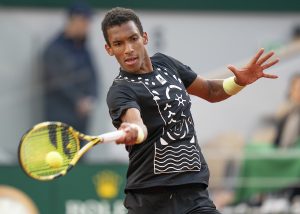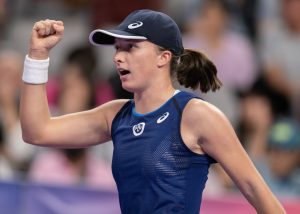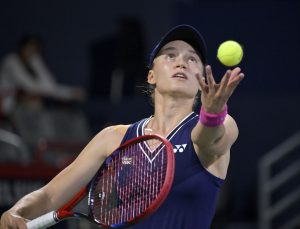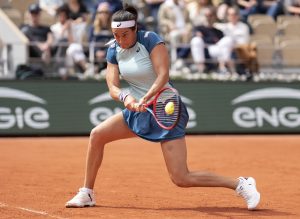Tennis, like all sports and indeed all aspects of society, continues to be affected by the Covid pandemic, especially with the Omicron variant creating a level of uncertainty and even alarm that has probably not been seen since the first wave of the disease in the spring of 2020. Increasingly, it seems that Covid is like The Mob and we are all like Michael Corleone: we keep trying to get out, but it keeps pulling us back in. However, it wasn’t just Covid that caused problems in tennis in 2021. There were also all the usual issues of scheduling, player welfare, and on and off-court ructions. Here, then, are 10 terrible things in tennis in 2021.
1.”No-Vax Djokovic”: the world’s most famous anti-vaxxer?
Even though he could not complete the Calendar Slam, in 2021 Novak Djokovic still had probably the greatest single season that any male tennis player has had in the Open Era (since the sport went fully professional in 1968). He won three of the four Majors, the highlight of which was his defeat of Rafael Nadal in the French Open semifinal, the third set of which alone was probably the best men’s match of the year; he reached the Olympic final, where he lost to Alexander Zverev; and he led Serbia to the semi-final of the Davis Cup while competing in both the singles and doubles formats. In addition, he also belatedly but entirely justifiably began to enjoy the public adulation that for a decade or more has been poured down on the other two members of the “Big Three”, Roger Federer and Rafael Nadal.
However, there was a downside to Djokovic’s 2021, which threatens to spill over into 2022. For the time being at least, there remains considerable uncertainty as to whether he will actually compete at the Australian Open next month because of his vaccine status – or lack of it. He has been entered into the tournament on the official list of entrants, but there is still no guarantee that he will actually play, because it is still not clear if he is fully vaccinated against Covid. There has been a suggestion, admittedly still just speculation, that he will instead seek some sort of “quarantine” before the tournament, which may not be enough to satisfy the Australian authorities – both sporting and political.
Djokovic’s stance on vaccination, or at least the perception of it, has arguably made him the world’s most famous anti-vaxxer, or at the very least the world’s most famous vaccine sceptic. At a time when Omicron is threatening to undo much of the good work achieved by the vaccination programme so far, by plunging us back into the mass hospitalisations and even mass deaths of the first and second waves of the virus, everyone who is not yet vaccinated is really long overdue reconsidering their position. If Djokovic is still unvaccinated, a figure with his global reach has a particularly pressing moral obligation to join the ranks of the jabbed.
In addition, those of us who are already vaccinated should step up our demands that others follow suit. During the pandemic, the Black Lives Matters movement has taught us all, especially white people, that it is not enough not to be racist – we have to be anti-racist. In the same vein, it is surely not enough now just to be pro-vax. We all have to be anti anti-vax. And that includes the world’s greatest male tennis player.
- The First Night-Time Sessions at Roland Garros
Covid continued to have a devastating effect on tennis throughout the first half of 2021 and threatens to wreak havoc again in 2022. For much of the first half of the year, tournaments were still played in front of no fans at all or very few fans. That was the case even at the Majors, with the Australian Open, the French Open and Wimbledon all oscillating between no capacity, reduced capacity and full capacity, with predictable frustration for fans, both those at the tournaments and those watching on TV.
Perhaps the worst situation came at Roland Garros in the spring. The French Open had its first ever official night-time sessions, after gaining approval from the Paris authorities and local residents to extend play late into the night. However, the hoped-for spectacle of great clay-court tennis under the lights proved to be horribly anti-climactic, as French Covid restrictions at the time, particularly in Paris, meant that no fans at all were allowed in to watch the night-time matches. Daniil Medvedev, who was one of the players forced to wait all day (when there were at least some spectators allowed in) before playing at night (when there were no spectators at all) was not alone in questioning whether Roland Garros had prioritised TV coverage and honouring its TV contracts at the expense of the players and the fans who were actually at the event.
- The Davis Cup
A true Tennis World Cup remains the biggest no-brainer in sport. A global team event, played once every four years (like almost every other World Cup) and perhaps even involving both men and women in one national team, which would make it the first gender-neutral World Cup in any sport, would arguably be second only to the actual World Cup – in football/soccer – for global interest and global eyeball capture. And yet it seems to remain as far away as ever, with the latest dreadful developments at the Davis Cup only pushing it further and further into the future.
Unlike the 2020 Davis Cup, which was cancelled because of Covid, the 2021 Davis Cup did at least go ahead, but that is about as much as can be said for it. Coming right at the end of another Covid-ravaged season, when many of the world’s best male players were either unfit or unwilling to compete, it lacked many of the sport’s star attractions. In addition, poor scheduling, which meant that some teams enjoyed more rest than others, and the almost laughable TV coverage even in major markets (in Britain, for example, Eurosport ceased its coverage after Great Britain crashed out, which would never happen at any other ‘World Cup’), meant that the tournament made almost no impact at all, even among dedicated followers of tennis, in a late autumn/fall period that was already crammed with other sport.
Of course, things are only likely to get worse with the move to the Middle East next year, and for the foreseeable future, as Gerard Pique and his Kosmos group of investors desperately try to recoup some of the cash they have wasted on this aberration of a tournament, which is now even worse than the flawed year-long format that it replaced.
- Tennis’s continuing lack of an off-season
Of course, the main reason that so many men – including Denis Shapovalov and Felix Auger Aliassime, who led Canada to the final in 2019 – did not appear at the 2021 Davis Cup was that it was staged at the very end of November and extended into early December. For too many men, extending the season into the last month of the year was just a bridge too far. In fact, the season has not really ended at all, with the Mubadala World Tennis Championship exhibition event taking place in Abu Dhabi last week and other pre-Christmas exhibition events, such as the latest iteration of the Battle of the Brits (between England and Scotland), only being cancelled at the last minute because of Covid.
Tennis is the only major professional sport not to have a proper, defined off-season, and Covid and the complications that it causes has only exacerbated that situation. It is arguable that the problems that the lack of a real off-season causes have been masked by the phenomenal, indeed almost inhuman, durability of the Big Three male players – Djokovic, Nadal and Federer. However, even two of those great players are finally beginning to exhibit the problems that can be caused by playing too much tennis for too long.
- Roger Federer’s entire year
At the beginning of Macbeth, it is said of the original Thane of Cawdor, the traitor who Macbeth defeats (for which he is rewarded with his title), that he had at least died nobly in battle: “Nothing in his life became him like the leaving it”. Well, to paraphrase (if not mangle) Shakespeare, it could be said of Roger Federer: “Nothing in his career besmirched it like the leaving it”.
Federer appears to be undergoing the slowest, most painful and at times the most embarrassing retirement of any major professional sportsperson. He barely played at all in 2020, because of injury and then the Covid restrictions. Then, in 2021, he made a few early season appearances, which invariably culminated in early exits from a tournament, before concentrating fully on the grass season. But the surface that he once bestrode like a colossus now seemed to slip and slide beneath his feet – literally so in his humiliating Wimbledon quarterfinal defeat against Hubert Hurkacz, which culminated in a third-set bagelling.
Of course Federer has the right to retire when he wants. However, he could also learn from others how to retire gracefully. His own idol, Pete Sampras, retired after winning his last Major, the 2002 US Open final, thus going out right at the very top. And more recently, Jo Konta, after two years that had also been badly disrupted by both Covid and injury, decided that she would leave the court for good while the memories of her playing at her best were intact.
For Federer, such memories are fading fast. Next month, it will be four years since he won his last Major, the 2018 Australian Open. Now aged 40, and following two virtual non-seasons, it is becoming increasingly unlikely that he will ever get back to anything like his best – i.e. Major-winning, or at least Major-competing – form. Worse still, there is a danger that Federer is just being greedy in wanting to go on indefinitely, presumably in the hope of winning more Majors. He has already enjoyed a spectacular late-career renaissance, when he returned in early 2017, after six months out through injury, to win three of the four Majors that he competed for over the next year. The chances of his enjoying another late-career renaissance are becoming vanishingly slim.
- Nadal’s Nadir?
When Novak Djokovic defeated Rafael Nadal in the French Open semifinal in early June, in what is arguably the greatest men’s clay-court match ever played, he may not only have ended Nadal’s domination of Roland Garros but perhaps the Spaniard’s career at the highest level. That may seem like a grandiose statement, but the fact is that Nadal has barely played at all since, missing out on Wimbledon, the Olympics, the US Open and the Davis Cup, and on the few occasions that he has played he has looked nothing like the player of old – a man who combined both toreador and bull in his extraordinary, indeed unique, on-court intensity.
Unlike Federer, who for most of his career had remained injury-free, Nadal has always struggled with injuries, to the extent that early on many experts predicted that his all-action style, especially on hard courts, would inevitably shorten his playing career. Equally, he has come back from injury many times before, so it would be foolish to right him off completely, especially when he still has the chance to become the greatest player ever, statistically at least, by winning a 21st Major before either Federer or Djokovic.
Nevertheless, there can be little doubt that he faces probably the biggest test of his career, both physically and emotionally. He did play at the Mubadala World Tennis Championship, where he lost to Andy Murray in the semifinal, but he has subsequently contracted Covid, which will further affect his chances of competing meaningfully at the Australian Open in January. And he had already said in interviews of his chances in Melbourne: “It’s going to be super difficult for me”.
Consequently, both Federer and Nadal face the most uncertain of futures. At their best, they undoubtedly remain among the elite, but it is also undeniable that they have not been at their best for a long time now: at least six months for Nadal; and far longer for Federer. As a result, with Djokovic still at his imperious peak, Daniil Medvedev now a Major winner and a major threat to anyone, and the likes of Zverev, Tsitsipas and a hopefully revitalised Dominic Thiem all challenging at the top, it is surely questionable whether either Federer or Nadal will ever make a Major final again, let alone win it.
- Naomi Osaka’s Ongoing Problems
Women’s tennis is the most competitive it has ever been, with four different Major-winners in 2021 (and two of them – Barbora Krejčíková and Emma Raducanu – winning their maiden slams) and a general level of competitiveness that is now so strong that virtually any woman in the top 100 has a realistic chance of going deep in a Major, if not actually winning it. Nevertheless, if any one woman in recent years has looked like becoming the dominant world #1 that the sport has traditionally had, from Chrissie and Martina to Steffi and Serena (champions so world-conquering and consequently world-famous that they were known simply by their first name), it is surely Naomi Osaka. However, the events of 2021 have only strengthened the suspicion that although the Japanese player may have all the physical and technical tools to win many more Majors, she may lack the mental resolve to do so.
That is not meant to be a criticism of the ongoing mental health issues that Osaka herself has drawn attention to, most notably at the French Open, when she initially refused to attend press conferences, for fear of the increasingly intrusive nature of the questioning ]that she faced, before meekly exiting the tournament in the first week. Such mental health issues should be rightly highlighted and addressed. However, it is also true that the very greatest champions in tennis, as in any sport, have the sheer single-mindedness, if not bloody-mindedness, to overcome almost any obstacle. Rightly or wrongly, it may be that the multi-faceted, endlessly charming but obviously troubled Osaka lacks that all-conquering mindset.
- Andy Murray’s Olympic defence
Andy Murray can always claim to be “The Fourth Man” in the era of “The Big Three”. Although Stan Wawrinka has won the same number of Majors as Murray (three), Wawrinka never ascended to the #1 ranking and nor did he win two Olympic Gold medals in Singles. Murray was always incredibly proud of being a double Olympic champion, in London in 2012 and then in Rio four years later. Indeed, it is arguable that winning that first Olympic Gold, on the grass of Wimbledon, was the key to unlocking all the self-belief that propelled him to winning his first Major, the 2012 US Open, just a few weeks later.
All of which only makes Murray’s Olympic defence in Tokyo this year all the more disappointing. Scheduled to play both singles and doubles at the Covid-delayed Games, he only managed one doubles match (alongside Joe Salisbury), which he lost, before withdrawing from the singles tournament without playing a single match.
It was desperately disappointing, and unfortunately things did not get much better for the Great Scot during the rest of the season. He did play some truly stunning tennis, not least at the US Open against Stefanos Tsitsipas in the infamous “toiletgate” match, but inevitably he then succumbed to defeat soon afterwards. Perhaps that was inevitable after nearly half a decade of injury problems, ever since he ascended to world #1 at the end of 2016, but it was still painful for his fans to watch and even more painful for him to experience.
As a result, 2022 is surely a key season for Murray. If he can get back to playing consistently well and reaching the latter rounds of tournaments, especially Majors, he will be encouraged to continue. If, however, he continues the disappointing pattern of playing well but losing early, he may well be forced to conclude that it is finally time to call it quits, knowing that he did everything humanly possible to try and prolong his career.
- Ajla Tomljanovic vs Jelena Ostapenko at Wimbledon
The aforementioned match between Murray and Tsistsipas at the US Open may well have been the most ill-tempered men’s match of the year, certainly at a Major, but it still had nothing on the third-round clash between Ajla Tomljanovic and Jelena Ostapenko in the third round at Wimbledon. That was a really bad-tempered match, to the extent that it will be fascinating to watch if sparks fly again whenever the two women next meet on tour.
After trading shots in a match that Tomljanovic eventually won 4-6 6-4 6-2, Tomljanovic and Ostapenko proceeded to trade insults immediately afterwards, both on the court and in their press conferences. Essentially, Tomljanovic accused Ostapenko of feigning injury so that she could have a medical timeout during the match, saying: “I knew she wasn’t injured”. Ostapenko responded by saying that she had been genuinely injured and that it was “very disrespectful” of her opponent to suggest otherwise.
Of course, this all seems like so much nothing when compared to the histrionics of McEnroe and Connors back in the day, but the serious point is that the defeat killed the momentum that Ostapenko had appeared to be generating during the grass-court season, after winning convincingly at Eastbourne. Four years on from her astonishing 2017 French Open victory, when she blew Simona Halep off court and seemed to herald the arrival of “OMG Ostapenko”, she looked to be getting back to something like that Major-winning form. But it all dissipated during an ill-disciplined match that she eventually lost.
- Benoît Paire
I was tempted just to write the words “Benoît Paire” and leave it at that, because any true tennis fan knows what a gigantic pain in the derrière the Frenchman has been throughout most of 2021. Although it is undeniable that the global pandemic has badly affected tennis, like all of society, meaning few or no fans, regular testing and a general erosion of the enjoyment to be had on tour, Paire seemed to take it all personally, as if the pandemic existed purely to put him off his game. And off his game it undoubtedly put him.
Paire played like a drain for much of 2021 but far more importantly he often played as if he did not want to be on court. Remarkably, he was officially warned by an umpire for a lack of effort in his first-round, straight-sets defeat by Diego Schwarzman at Wimbledon, but that was only the culmination of a series of listless, if not downright lazy, performances throughout the first six months of the year. At a time when many people were still not able to work at all because of Covid restrictions, Paire appeared to derive little or no pleasure from doing the greatest job in the world – being a professional tennis player. With his dreadfully long and straggly beard, he looked like a member of the Taliban, and for much of 2021 he played what might be called “Taliban Tennis” – joyless, juiceless and ultimately useless tennis.
Next time: 10 Things To Look Forward To In Tennis In 2022
Main photo:
Embed from Getty Images






